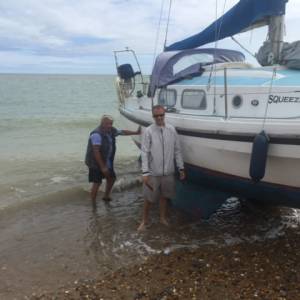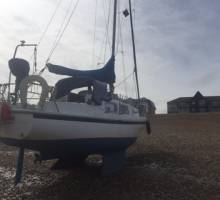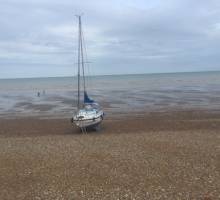
Boatshed Brighton's Dan King and Squeezebox's Adventures
My friend Paul and I set out at 4pm one Monday earlier this month for a leisurely overnight passage to St Valery sur Somme aboard my 23ft vintage yacht Squeezebox, a Westerly Pageant.
Conditions were benign, a 10 knot wind from the SW on a rising tide in a flat sea. As night fell the wind died away so on went the motor. The sea was so smooth we could see the reflections of Mars, Jupiter and dozens of stars in it.
Passing through the British side of the traffic separation zone was no problem but in the middle of “no man’s land”, some 27 nm from Eastbourne, at 11.30pm, the boat jolted suddenly and the engine stalled. I immediately went into neutral gear and looked over the stern. Nothing in sight, no rope, no buoy or flag stick. I reversed to and fro a dozen times but the engine refused to go above 1000rpm. Something had massively fouled the prop, if it was still there. There is no room on my prop shaft for a cutter.
I lifted the cockpit duck boards and removed the engine inspection hatch. The prop shaft seemed stiff but could rotate.
The stern gland needed a lot of grease to refill it, a messy job at sea in torchlight. But engine revs stayed stubbornly just above tickover.
We could see the lights of several fishing boats some three to five miles away and were drifting SW at about 1kn with no prospect of sailing out of trouble.
I radioed the Dover coastguard and before 1am the Eastbourne lifeboat arrived. I fitted their towing line onto my central bow cleat and at 4.30am we arrived back in Sovereign Harbour. What heroes!
After a hearty cooked breakfast at the pontoon opposite the lifeboat Paul went home while I waited for the marina work boat to take me to the boat lift or my berth.
I loosened the warps and gingerly nursed the boat backwards and forwards for fifteen minutes. I reckoned by now I could make 1.5 kn so radioed the marina and said I could limp back to my berth. They put out a general call warning other boats on the move but that did not deter a large power boat sweeping under the north bridge just as I approached it.
Back at the berth I tried poking around the stern, it seemed like the prop was still there. Then Chris and Amy arrived in the Premier work boat and with Amy and I leaning out of the pulpit Chris was able to pull a piece of yellow netting from the prop. He said there’s a lot more of it.
The following day I screwed a sharp kitchen knife to one end of two pieces of 2x1 screwed together in an L shape and poked around in front of the rudder. Out came more netting and a load of weed. I then motored around the north harbour managing 2 to 3 kn. I decided the following day would be a good time to beach the boat near Fisherman’s Village at the easternmost end of the Sovereign Harbour Estate.
Two hours after high tide with another friend Peter at the tiller Squeezebox motored round to where Paul was on the beach. “Just like the D day landings!” said Pete as the keels ran onto the shingle. Conditions were wave height max 2 ft and wind speed 8 to 12 kn.
I had taken the precaution of telling the Eastbourne coxswain Mark Sawyer that I was doing this, just in case a concerned member of the public thought we were shipwrecked!
The pictures tell the rest of the story.
The fouling was caused by a close mesh sack of the type used for bagging mussels or fruit, not a fishing net, which was floating free and invisible beneath the surface.
About three bucketloads of barnacles were scraped off the keel. Many beach walkers asked if we were OK. One young lad who said “looks like you’ve got a problem mate” promptly got a lecture on bilge keelers.
As the tide receded I walked the kedge anchor on 60ft of rope fixed to an aft cleat towards the sea, to stop Squeezebox being pushed up the beach when the tide came back in
After 9pm the sea was was under Squeezebox and it gently rocked as it tried to refloat. When I was sure the seawater inlet was covered I put the engine on tickover and checked sea water was being drawn in and expelled.
When the boat was afloat at the stern I revved the engine in reverse and tugged on the rope as Paul steered with the tiller. As the boat swung round towards the sea I quickly pulled the rope and anchor aboard and we motored round to the marina, following the Royal Sovereign fishing boat into the lock. We got back to the berth about 10.30pm.
I would recommend this exercise to any yacht with twin keels. Notwithstanding the net removal Squeezebox is sailing much easier and smoother with a clean bottom and smooth prop. It is a good mid season fix before the boat comes out in the autumn for annual maintenance.
If any other berth holders want more advice on doing this please feel free to contact me.




